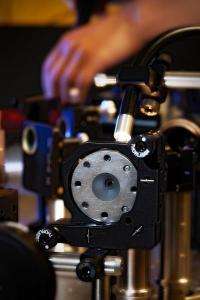First ever single crystal metallic glass created under 25 gigapascals of pressure

Glass, by definition, is amorphous; its atoms lack order and are arranged every which way. But when scientists squeezed tiny samples of a metallic glass under high pressure, they got a surprise: The atoms lined up in a regular pattern to form a single crystal.
It's the first time researchers have glimpsed this hidden property in a glass. The discovery, reported June 17th in Science, offers a new window into the atomic structure and behavior of metallic glasses, which have been used for decades in products such as anti-theft tags and power transformers but are still poorly understood. The more scientists learn about the structure of these commercially important materials, the more effectively they can design new metallic glasses and tinker with old ones to improve their performance.
"Maybe a lot of glasses have this underlying structure, but we just didn't know how to look for it," said paper co-author Wendy Mao, a mineral physicist at the Department of Energy's (DOE) SLAC National Accelerator Laboratory and Stanford University.
Daniel Miracle, a metallurgist at the Air Force Research Laboratory in Ohio who was not involved in the research, called the discovery "a really, really neat, important finding." Not only will it help researchers design better metallic glasses, he said, but it may help explain why these materials can be so tough: If each piece of glass is a single crystal at heart, it doesn't have any of the weak spots at the boundaries between crystals where fractures and corrosion tend to start.
Unlike familiar window glass, metallic glasses are alloys made of metals—in this case cerium and aluminum. They resist wear and corrosion and they have useful magnetic properties. If you took apart the plastic anti-theft tag on a DVD case, you'd find a thin piece of metallic glass that looks like aluminum foil. When you rent or buy a DVD, the checkout clerk rubs it across a pad to demagnetize the metallic glass so it won't trigger an alarm when you leave. By placing the cerium-aluminum glass under 25 gigapascals of pressure -- about 250,000 times normal atmospheric pressure -- the team was able to create a single crystal.
Scientists have been investigating metallic glasses for half a century, and in 1982 turned up the surprising discovery that these glasses do have some atomic structure, forming patterns over distances spanning just a few atoms. But no long-range patterns were apparent.
"The structure of glass is still mysterious. We know little about it, even though we use glass a lot," said Qiaoshi (Charles) Zeng of Zhejiang University in China, who led a research team of scientists from SLAC, Stanford, the Carnegie Institution of Washington, George Mason University and China's Jilin University. "And it's not easy investigating the structure of glass by traditional methods."
Zeng, Mao and their colleagues were not looking for order when they squeezed samples of the metallic glass between the tips of two diamonds at Argonne National Laboratory's Advanced Photon Source, applying 250,000 bars of pressure (250,000 times the pressure of the Earth's atmosphere at sea level). They were simply doing a series of experiments on how materials behave in extreme conditions.
All the samples were taken from a centimeter-long, extremely thin ribbon of the metallic glass. Under intense pressure, all of the samples "devitrified," abruptly switching out of their glassy state to form a face-centered cubic crystal—one whose atoms are arranged like ping-pong balls packed into a box.
What's more, all the atoms in the crystallized samples lined up in the same direction—an indication, the researchers wrote, that this underlying structure ran throughout the whole ribbon of glass, and was put there when the glass formed.
Zeng, who will be joining Mao's group at Stanford in July, said the high-pressure technique may offer a new approach for making single-crystal materials from glasses. In addition, he said, it provides a unified understanding of the atomic structures of materials by directly linking the two most extreme examples: highly ordered single crystals and highly disorganized glass.
Provided by SLAC National Accelerator Laboratory



















